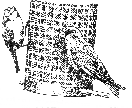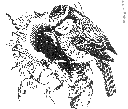|
There is More to Life than Growing Fuchsias
As show date approaches the Show Secretary and Committee members are usually getting increasingly anxious, wondering if sufficient entries will materialise to live up to our reputation of staging really good shows.
Hence a lot of 'egging on' to chase up folks who have been know to comment during shows that they had better plants at home, and encourage others, who feel their plants might not be good enough, while we know they jolly well are, etc. etc.
'Excuses' often heard include too busy, increased work commitments and troubles with pests or diseases. But when asking my fellow committee member Aubrey Brooker, a complete new one was mooted. "Too many birds in my greenhouse".
Right, okay, perfectly acceptable that with page three girls around not enough attention can be paid to fuchsias, one can fully understand that.
Oh sorry, I got that wrong. Of course Aubrey meant the feathered kind, real birds, flapping about and causing havoc!
During spring and early summer birds found in his greenhouse from time to time have included a wren, sparrows, blackbirds, a magpie and blue tits. These are usually young fledglings. When you enter the greenhouse they often get a real fright (more than we do!) and fly about in panic doing a lot of damage. I have had wrens and blue tits in my greenhouse too on occasions and have usually retreated swiftly, opening the big double door as widely as possible to give them a clear hint of how to depart. I dread to think of big ones like blackbirds and even magpies getting in. Phew - what havoc they could create.
The reason there are so many birds in their garden is that Aubrey and Ann are keen bird watchers, members of the British Trust for Ornithology. They participate in an interesting national bird watch scheme. People have to observe the number of birds of each specie feeding at any given time in their garden. Reports are sent in to the BTO four times a year and a quarterly newsletter 'The Bird Table' is produced incorporating the findings. Aubrey lent me some issues and they made interesting reading. Lots of background information regarding the changing patterns of garden birds and their life styles.
The types of birds most often recorded at their Hunmanby Gap garden include: house sparrow, great tit, blue tit, dunnock, willow tit, robin, blackbird (native & migrant), starling, dove, chaffinch, greenfinch, wren, merlin, wood pigeon, pheasant, magpie, sparrow hawk and hen harrier.
To encourage the birds they are fed with peanuts (safe ones), corn, seeds, sultanas, bread, lard mixed with seeds, fat balls and sunflower seeds.
I always make sure I have water available for the birds and a steady flow can be seen drinking and bathing. Especially crucial when natural puddles are iced-over in frosty weather or non-existent in dry hot weather. Personally I don't really feed them, thinking that is must be best just to let nature take its course. Plenty food available in our mixed garden, full of berries, seeds heads, left on for them during the winter months, and other goodies under shrubs or in the hedgerows. However, on a TV programme the other day Bill Oddie did point out that adult birds do seem to feed their young on the natural food found, but benefit greatly from feed left out for them, for their own consumption, thus saving strength scavenging for it. Interesting point, indeed food for thought! Apparently favourite titbits are whole peanuts and sunflower hearts for the adults and live mealworms for the fledglings.
Quite a fascinating hobby really. We let Aubrey off then, but hope he'll manage to net part of his set up so we'll have him back showing this year! CD
|
|

